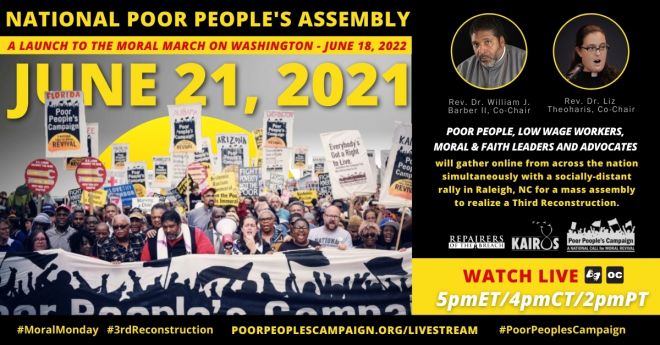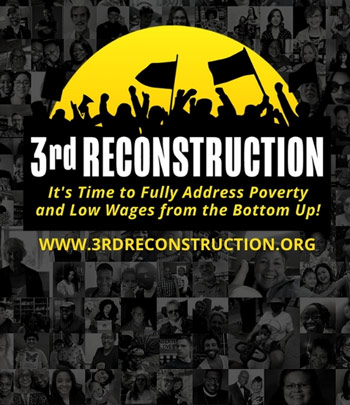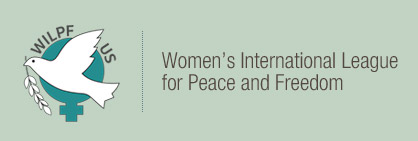Poor People’s Campaign Launches a Third Reconstruction
Published on June, 31 2021
The Poor People’s Campaign: A National Call for Moral Revival is engaged in “moral fusion organizing” and continuing to build a transformational movement. Participate in upcoming actions on June 7 and June 21!
By Dorothy Van Soest
WILPF Liaison to the Poor Peoples Campaign
WILPF Women, Money & Democracy Committee
June 2021
It’s time to fully address poverty and low wages from the bottom up! Emerging from the pain and organizing power of the 140 million people living in poverty or with low wages in this nation, the congressional resolution for a Third Reconstruction reflects an omnibus vision for a fundamental restructuring of society that lifts from the bottom. The non-partisan resolution comes as a response to years of movement-building to create the collective resolve necessary to implement real and transformational legislative action.
—www.poorpeoplescampaign.org
Participate in upcoming Poor People's Campaign: A National Call for Moral Revival actions on June 7 and June 21, and read on to learn about the initiative to fight forward for 500 days to a Third Reconstruction. In order to be effective partners in this transformational movement, we need to have a deep understanding of the following transformative organizing and mobilizing principles and strategies.
What is Moral Fusion Organizing? Moral fusion organizing is a grassroots organizing and movement building strategy that is aimed at shifting the narrative and building power. It is a moral movement, not about left versus right but about right versus wrong. It goes beyond single-issue organizing, sees that the same forces allied against poor people are working against Black and brown people, LGBTQ people, the environment, education, and healthcare. It addresses, simultaneously, the interlocking injustices of systemic racism, poverty, ecological devastation and the denial of health care, militarism and the distorted moral narrative of religious nationalism that blames the poor instead of the systems that cause poverty.
If they’re cynical enough to stick together, we ought to be smart enough to come together. That’s moral fusion organizing. It’s what brought white and Black people together in a moral movement for abolition and women’s suffrage. It’s what brought civil rights and labor together in the civil rights movement.*
What does it look like? It looks like undocumented folks in Los Angeles connecting with homeless organizers in Salinas and policy experts in Sacramento. It looks like families struggling with poverty and anti-voter suppression activists in Mississippi rallying together even when dogs and extremists try to intimidate them. It looks like a fast-food worker in Virginia standing alongside Fight for $15 activists and declaring, “I’m poor, I’m white, and I’m here. This hillbilly is joining other poor people of all colors, all sexualities, all religions . . . our backs are against the wall and we have no choice but to push.”**
How do we get to the “we” of fusion organizing? We recognize the divide-and-conquer strategy that has always been used by the forces working against injustice. We refuse to pit poor working people against immigrants, Muslims, and LGBTQ neighbors; we know that is the same as the generations-old myth that no matter how bad off white people were, they were better than a slave. We invite people into a new community—one that brings together Black, white and brown, rich and poor, gay and straight, all faiths and no faiths. We take the time to learn how to be together and hold each other up. We bond by taking action together. We know the resistance we meet is our confirmation. As Gandhi said, “First they ignore you, then they laugh at you, then they fight you… and then you win.”
 What does it mean to launch a Third Reconstruction? It means understanding what Reconstruction was about after the Civil War and how, as the first fusion movement of whites and Blacks, it was resisted by the Klan and led to a Jim Crow “Redemption” movement that was aimed at deconstructing the gains made and restoring white supremacy to our land. It means understanding that the Civil Rights Act, Voting Rights Act, and War on Poverty were also achieved through the moral fusion organizing of a civil rights movement. It means understanding that a Third Reconstruction aims to address the fundamental injustice at the heart of America’s story about how we stole this land from Native Americans and built a nation with the stolen labor of enslaved Africans.
What does it mean to launch a Third Reconstruction? It means understanding what Reconstruction was about after the Civil War and how, as the first fusion movement of whites and Blacks, it was resisted by the Klan and led to a Jim Crow “Redemption” movement that was aimed at deconstructing the gains made and restoring white supremacy to our land. It means understanding that the Civil Rights Act, Voting Rights Act, and War on Poverty were also achieved through the moral fusion organizing of a civil rights movement. It means understanding that a Third Reconstruction aims to address the fundamental injustice at the heart of America’s story about how we stole this land from Native Americans and built a nation with the stolen labor of enslaved Africans.
What is 500 Days of Fighting Forward? A nationally coordinated campaign from February 1, 2021 to June 18, 2022 is aimed at changing the fundamental system that perpetuates the five interlocking injustices, not incremental or piecemeal solutions. It isn’t just a series of rallies and actions but a moral fusion organizing and mobilizing strategy aimed at changing the narrative and building power through several pulling points:

How can I learn more and take action?
- Register at www.poorpeoplescampaign.org for details and updates about the 500 days. Click on the link to your state to find actions in your area
- Study the 14 Steps to Moral Fusion Organizing
- Read and get support for the resolution, Third Reconstruction: Fully Addressing Poverty and Low Wages from the Bottom Up: 3rdreconstruction.org
- Read and discuss Rev. Barber’s recent books: Forward Together: A Moral Message for the Nation and The Third Reconstruction
- Mark your calendars – participate in the June 7th and June 21st actions, inform and invite others.
WILPF is proud to be a long-standing national mobilizing partner of the Poor People’s Campaign: A National Call for Moral Revival.
References:
* Q&A with Rev. Dr. William J. Barber II, Exhibition, Fall 2017.
** Rev. Dr. William J. Barber II and Rev. Dr. Liz Theoharis, "Creating a Moral Movement for Our Time" The Nation, August 8, 2018.



